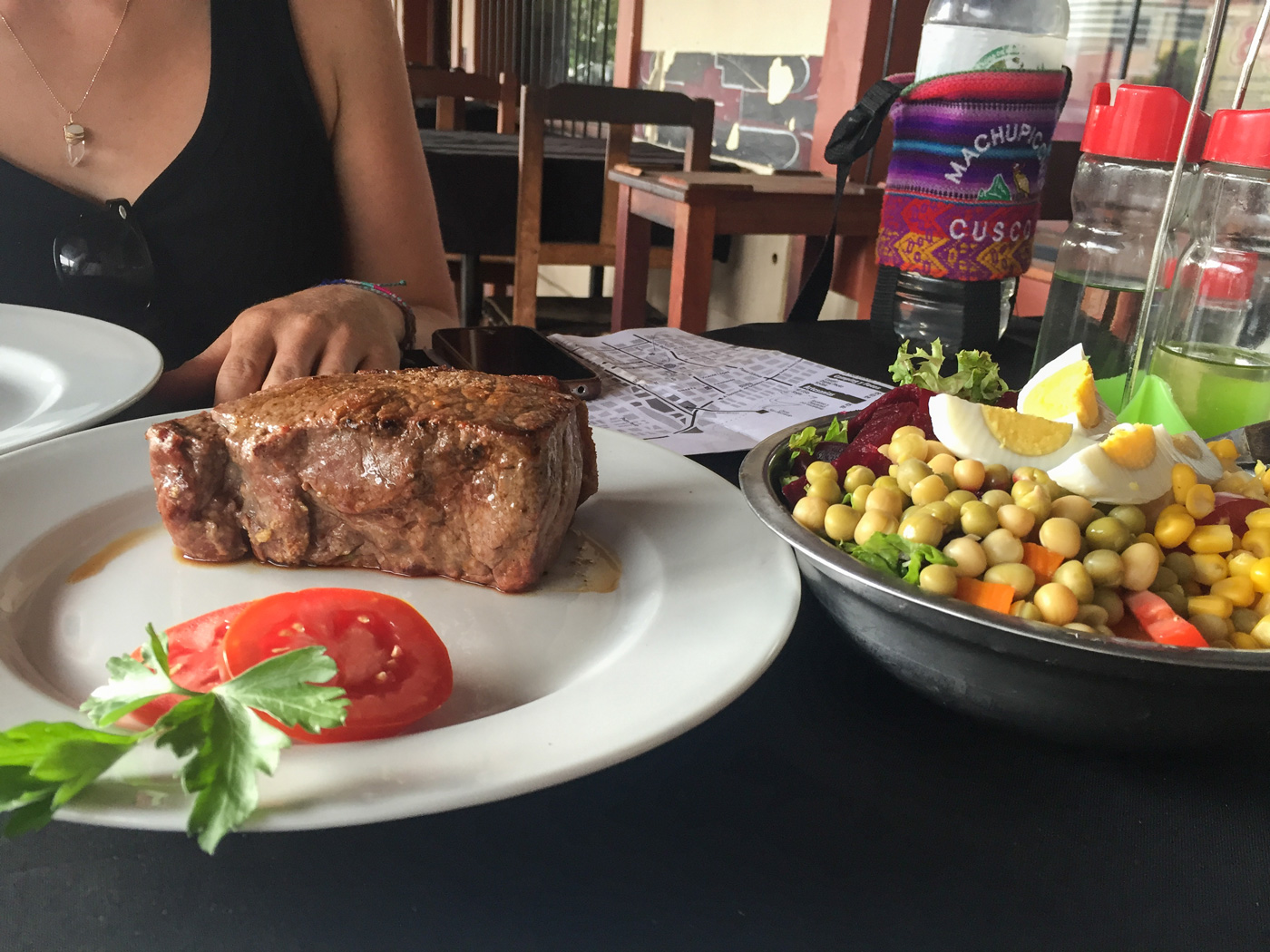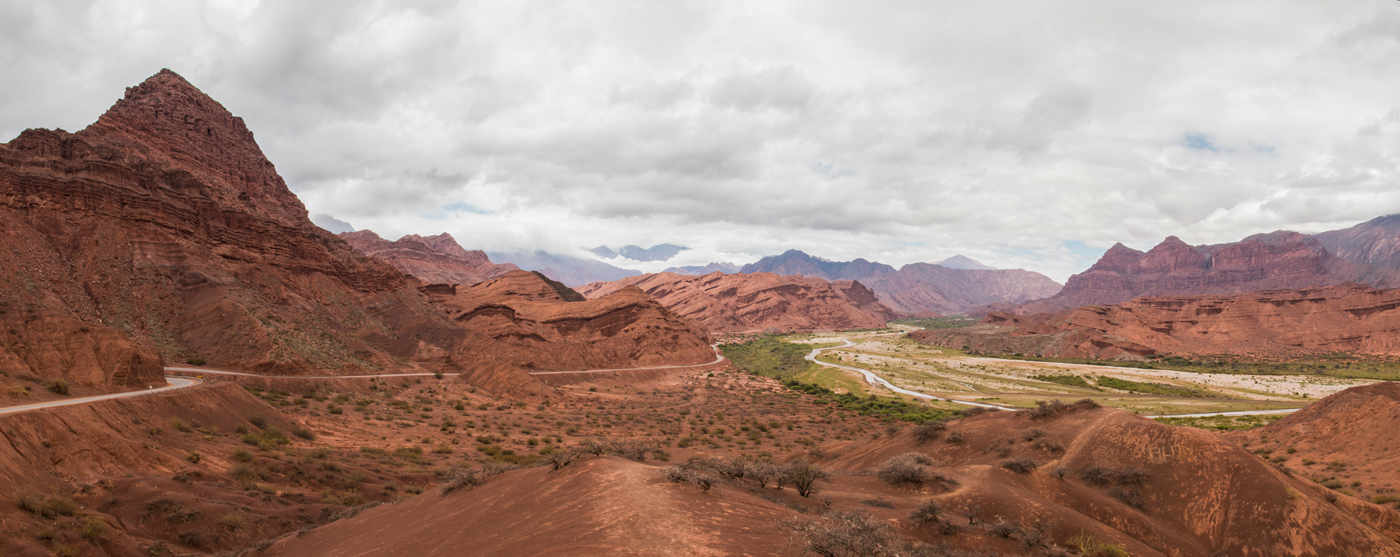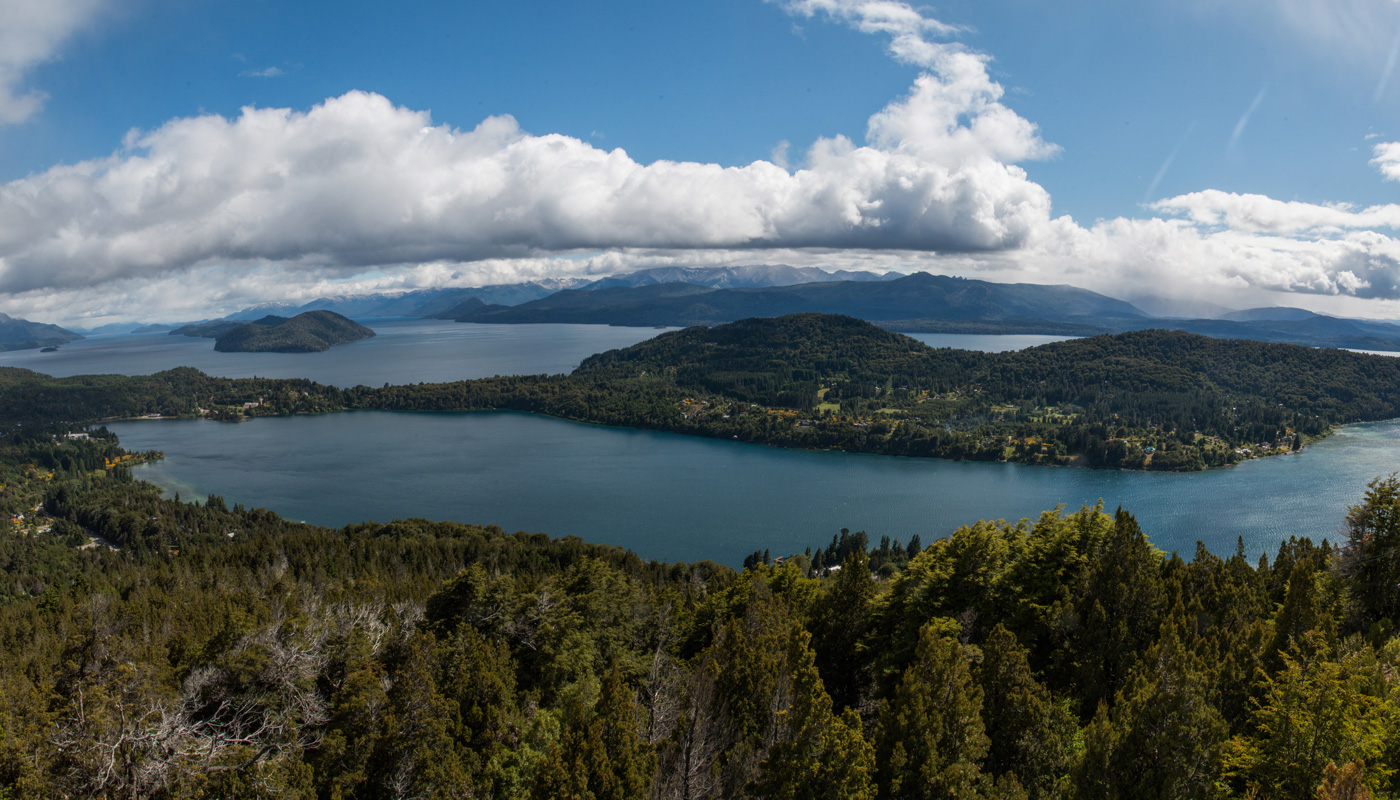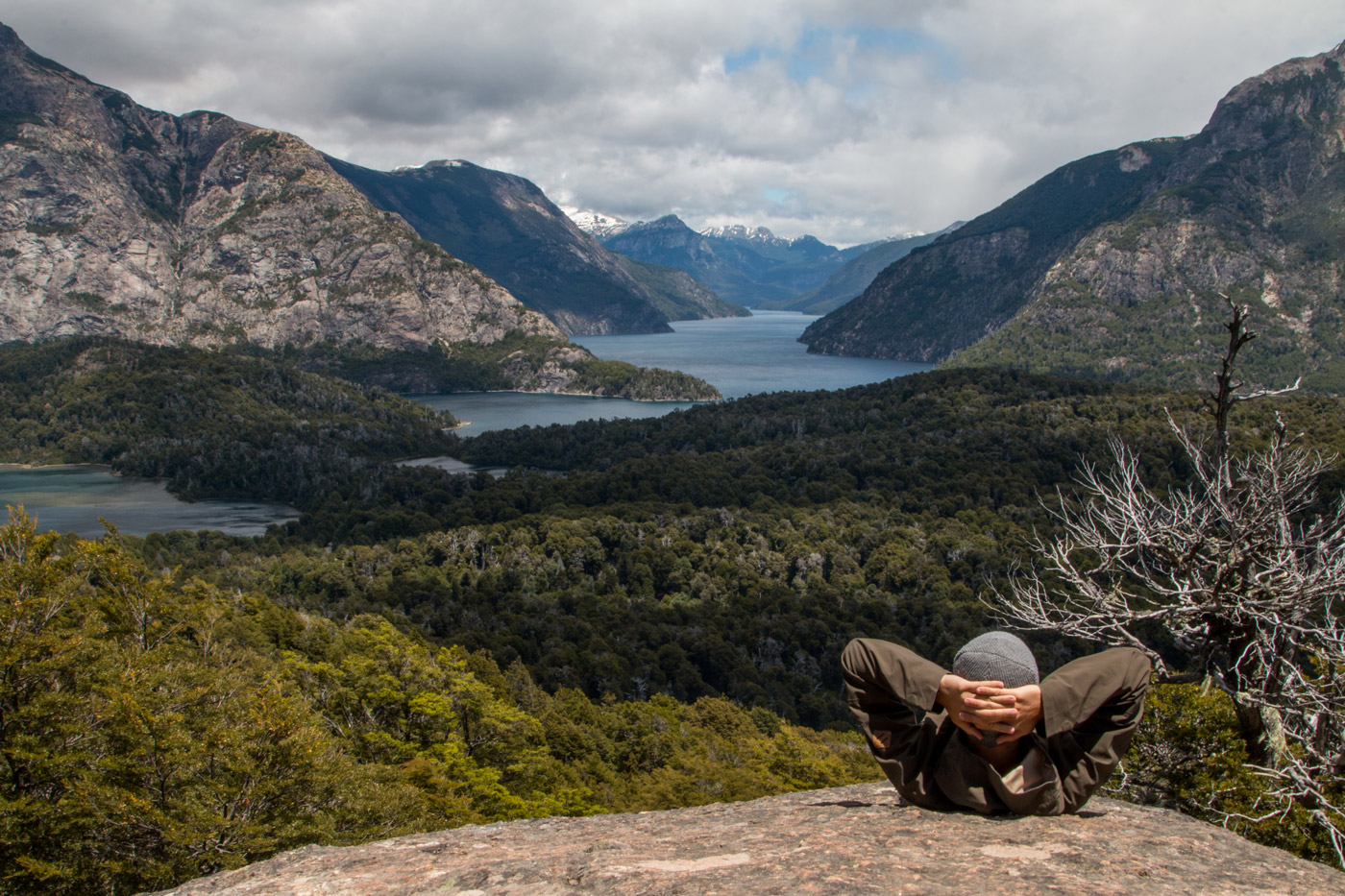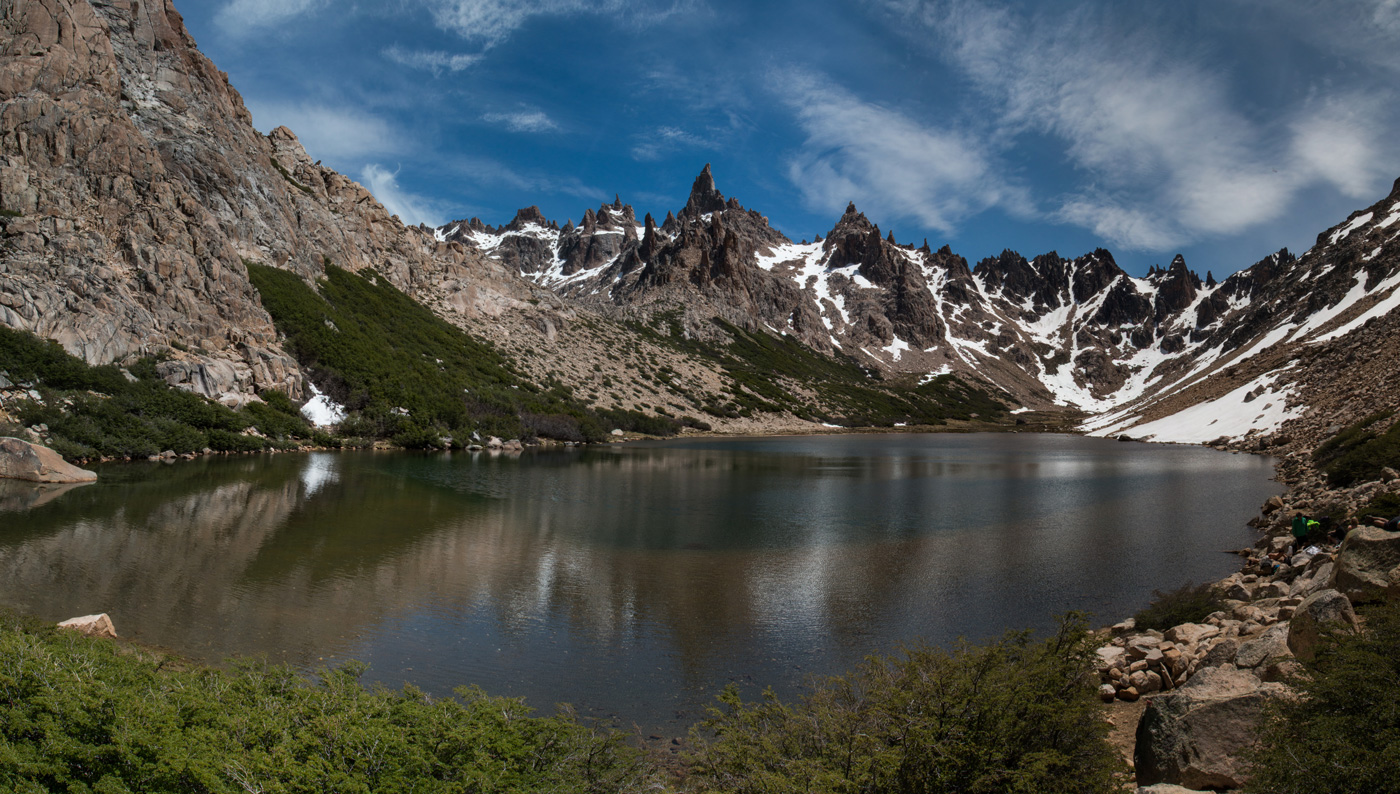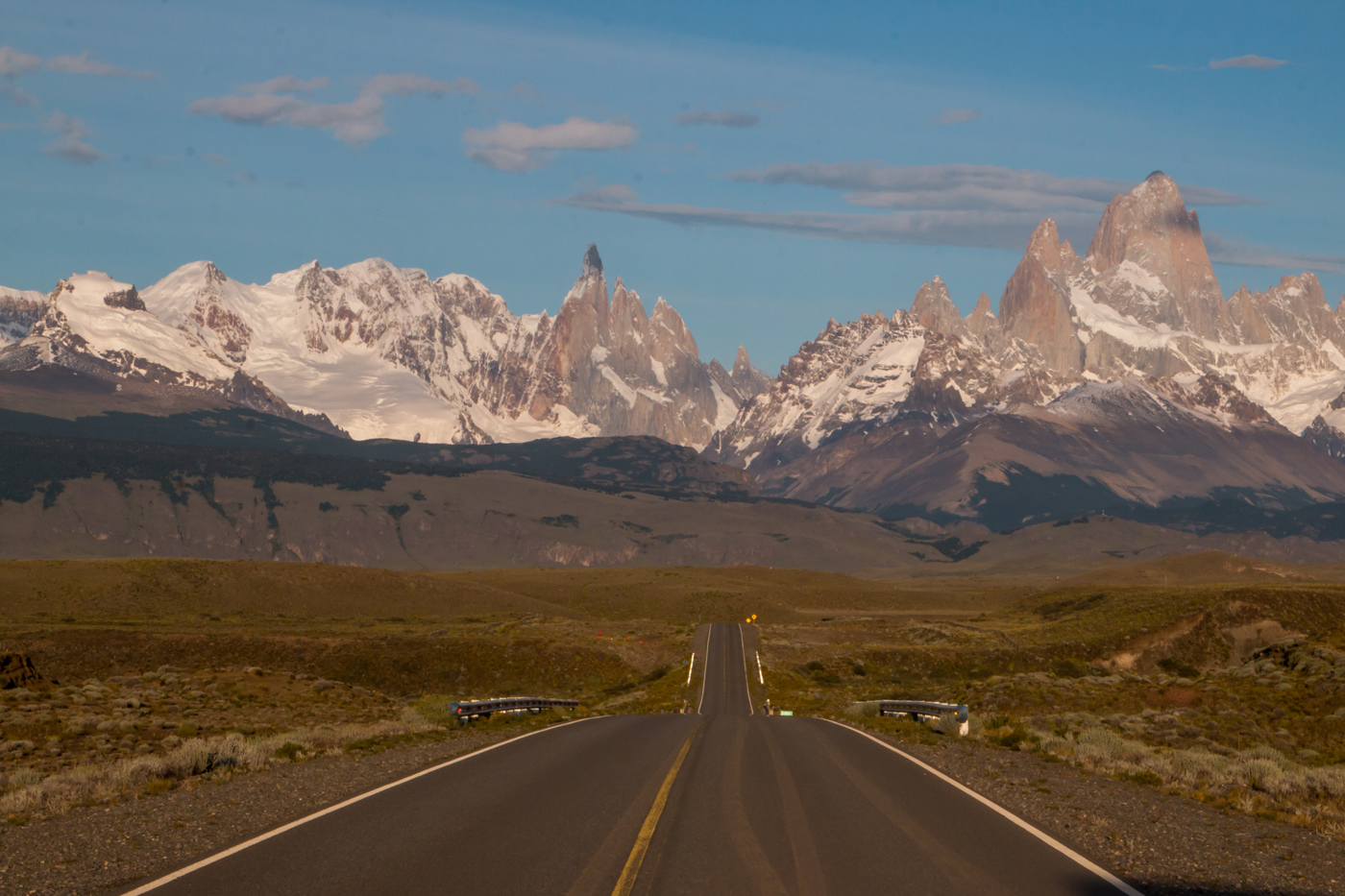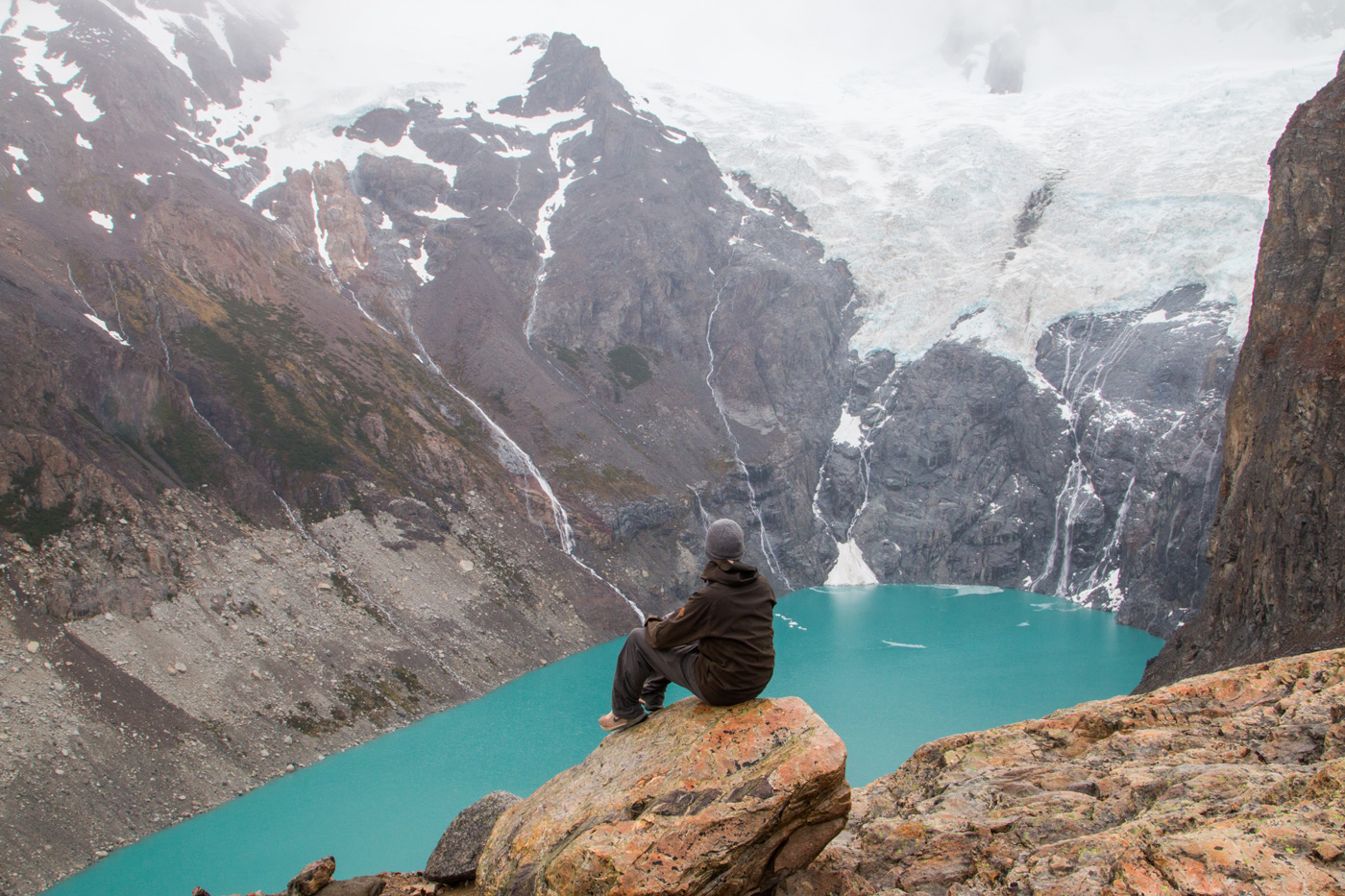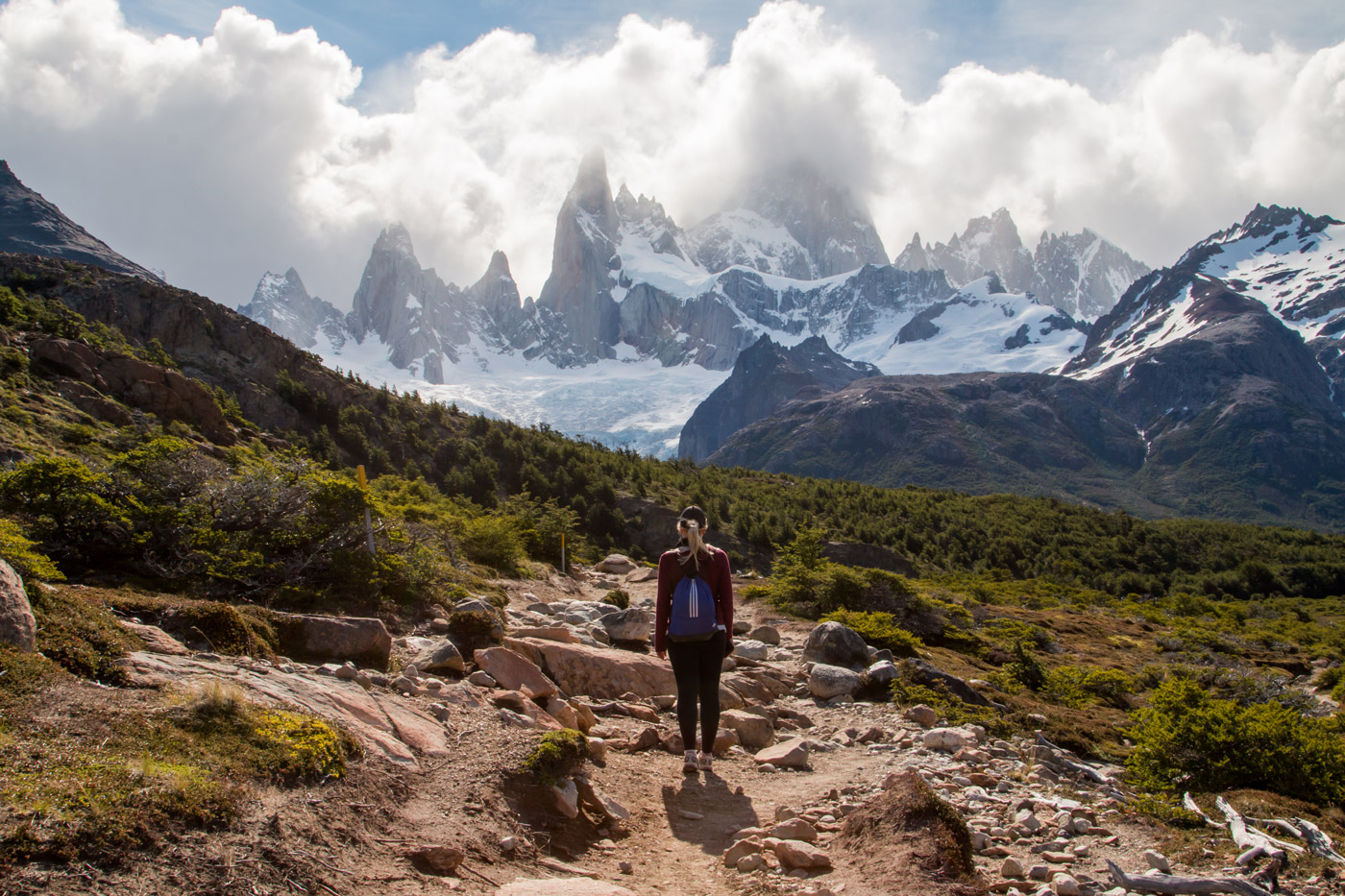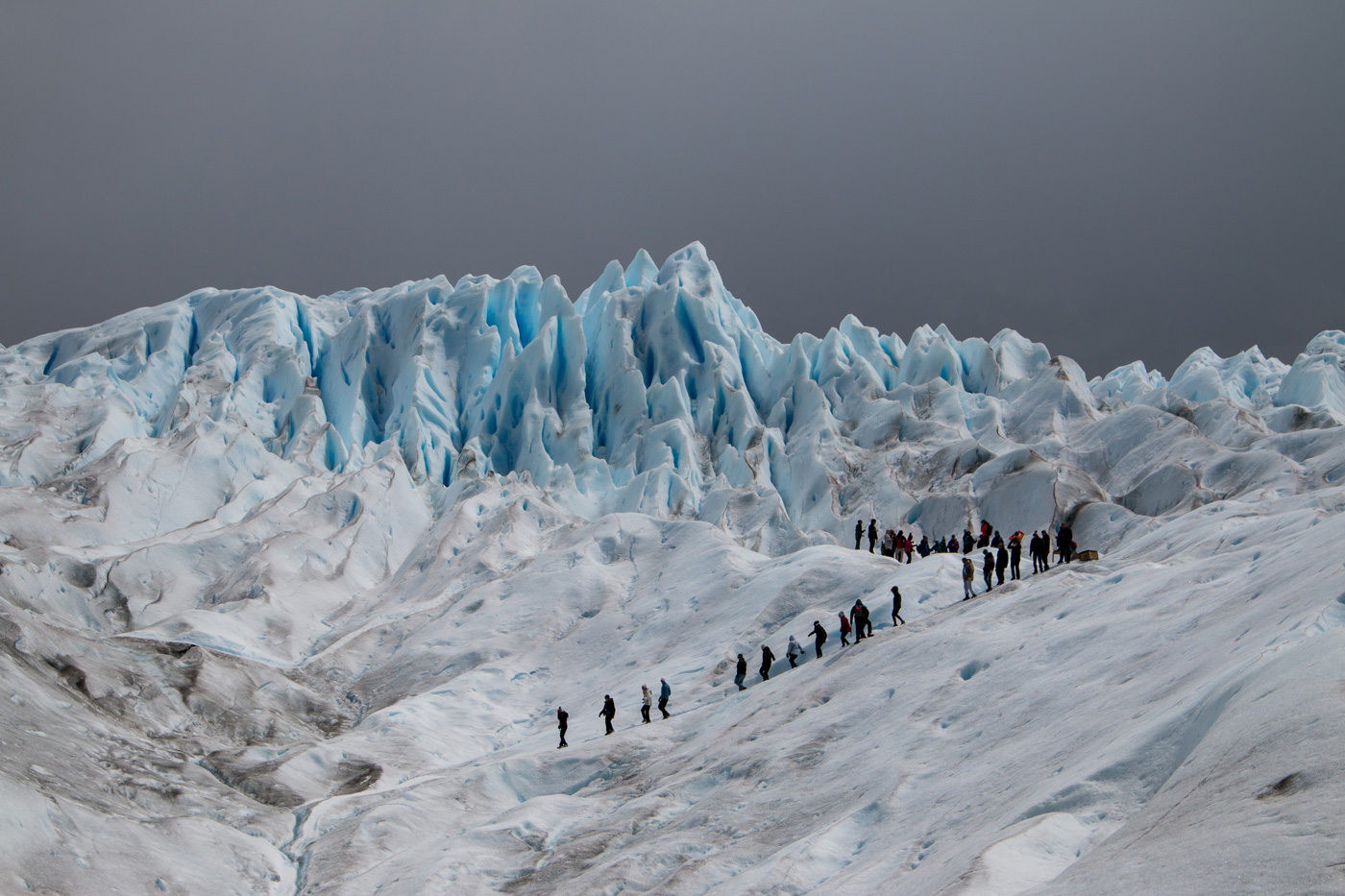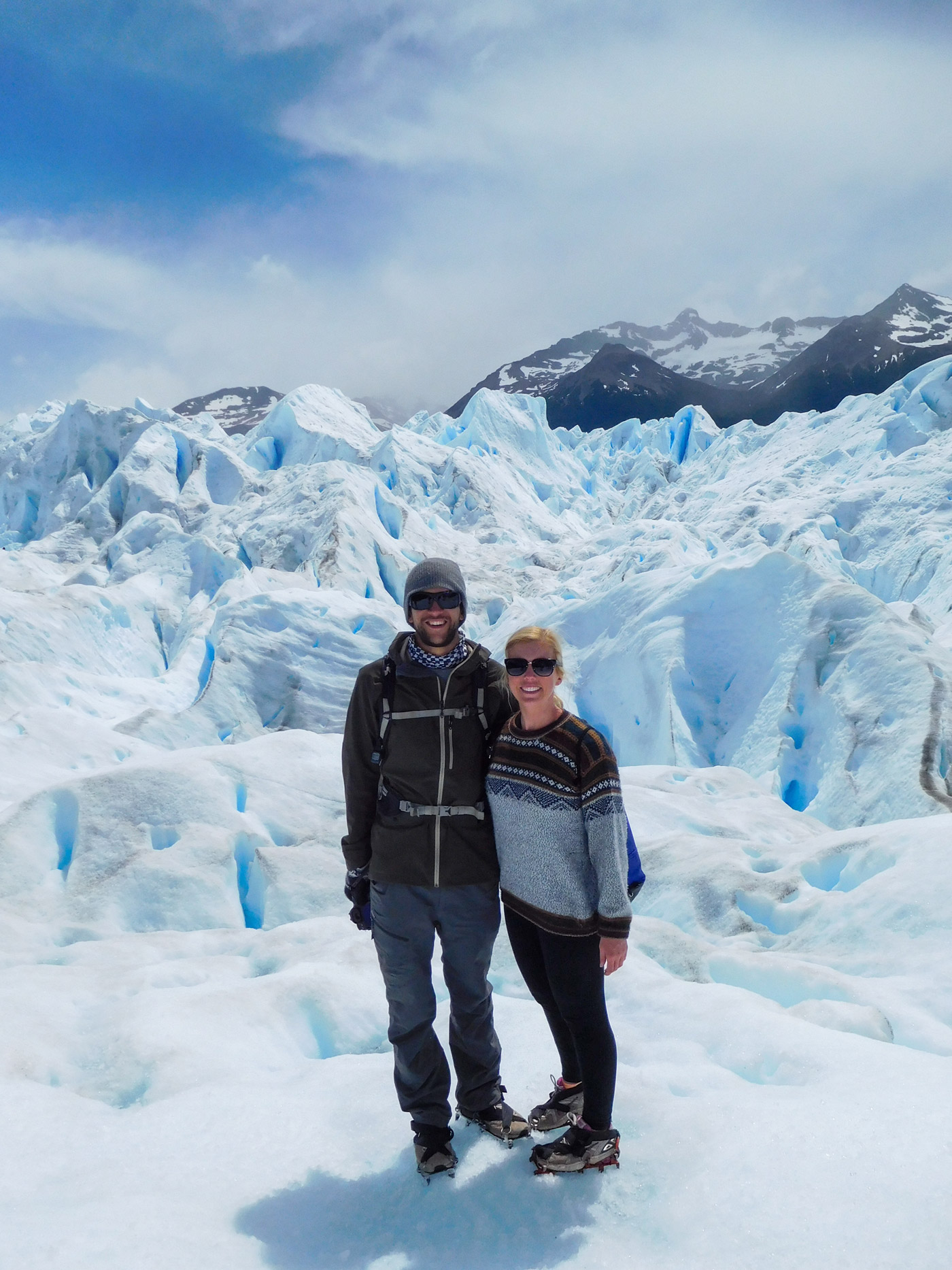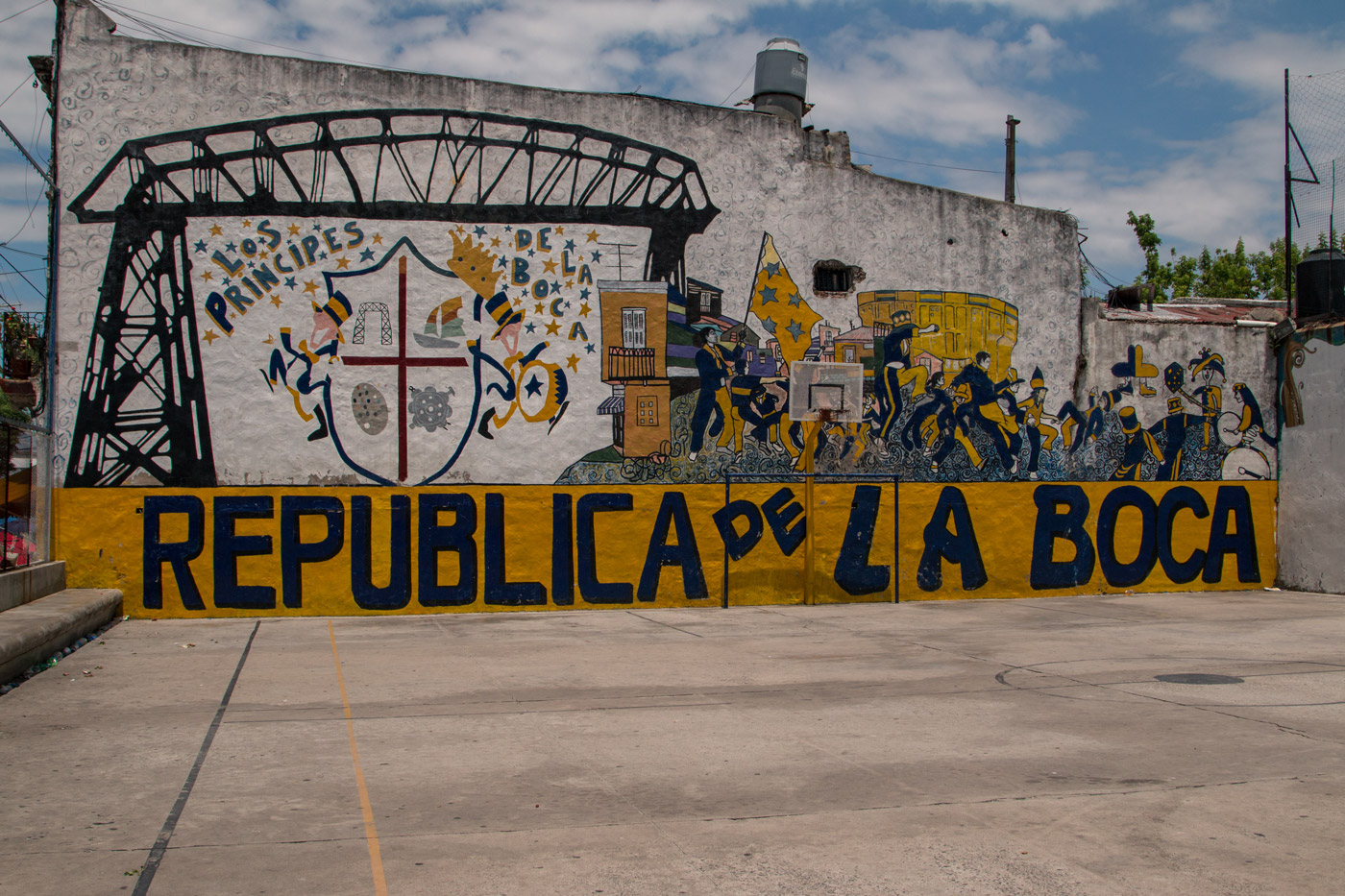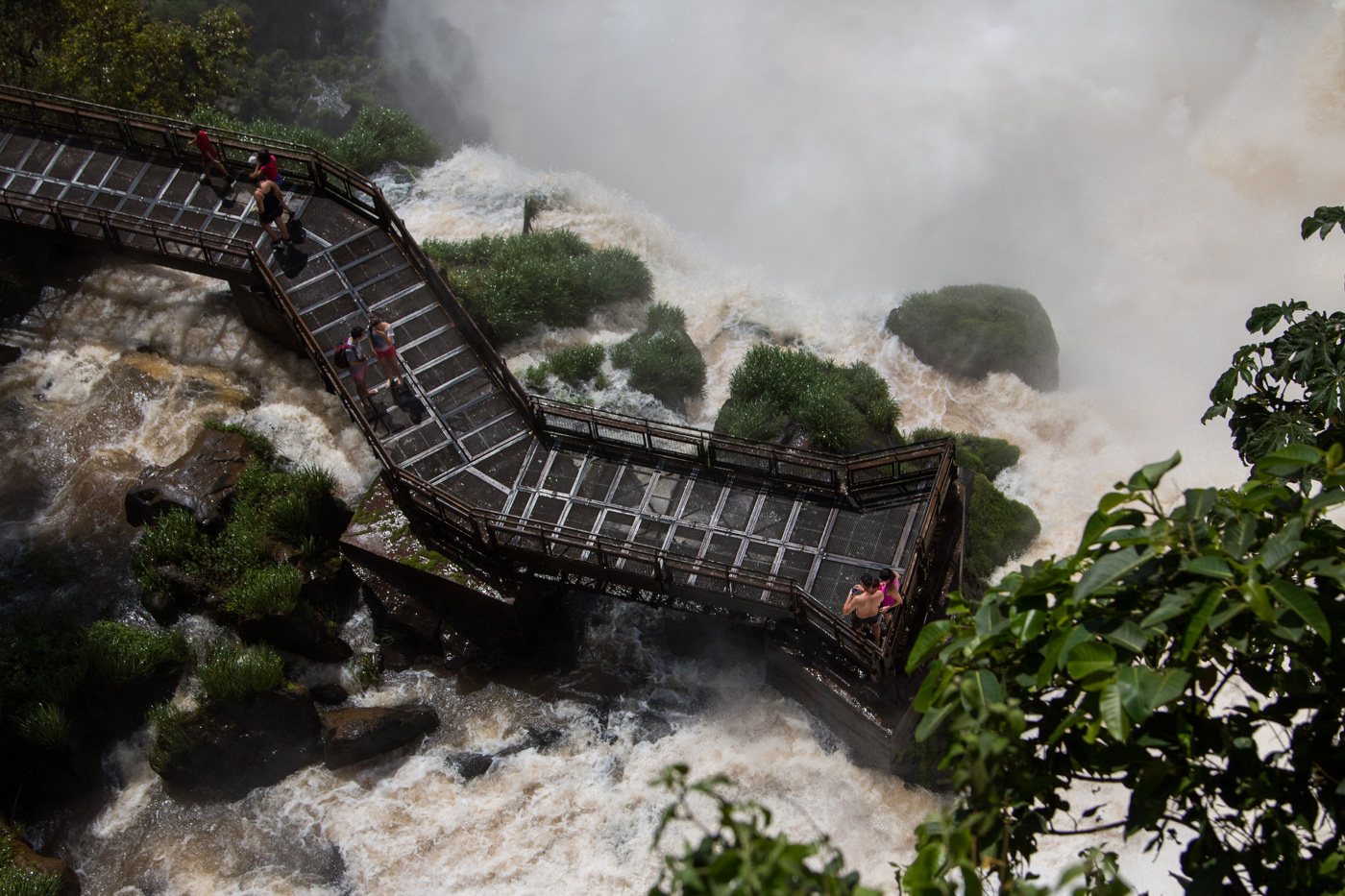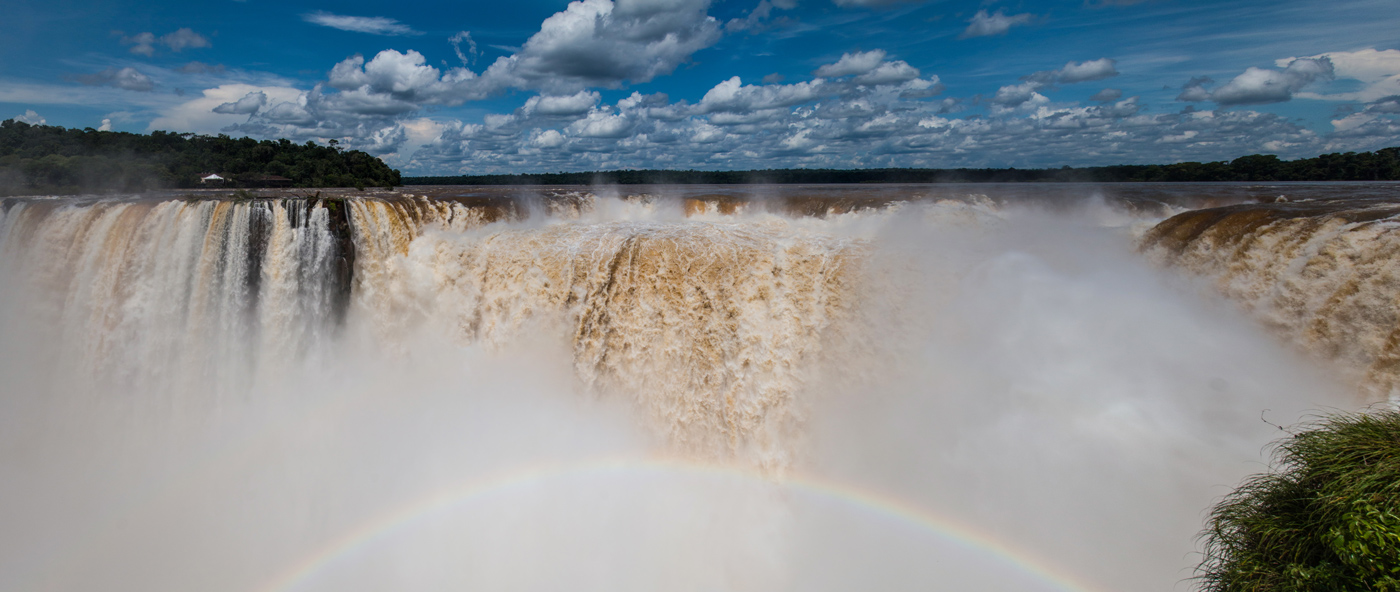With a long bus through the desert from San Pedro de Atacama we arrived in Salta, our first stop in Argentina. As explained in my previous post we moved in and out of both Argentina and neighbouring Chile as we made our way down the continent in order to avoid any backtracking through the long, skinny countries.
Upon entering Argentina the first point of call was a much anticipated Argentinian steak. I had been hearing nothing but good things about the quality and size of their meat portions as we made our way through South America, and so it was safe to say it was something I was very much looking forward to. I continued to eat steak for dinner five times in the next six days, only making the mistake of straying to chicken once. The size of the steaks would bring a vegetarian to tears, the prices were amazingly good value and they were always cooked to perfection. In our month long stay in the country steak became my regular meal, sometimes even twice a day…
Salta is located in the north west of Argentina, and is a populated city with old, colonial architecture. Like all Spanish cities it had a prominent town square with a cathedral, town hall, museum, a park and plenty of restaurants. We had been advised by several people in the months gone by about Argentina’s unofficial “Blue Dollar” currency market and to stock up on as much US Dollar as we could prior to entering Argentina. This black market currency exchange was born out of necessity for local citizens to get around the governments tight currency controls and instability of their Argentinian Peso in what is a poorly managed country and economy. Despite this parallel market being considered illegal the people making use of it are far from your typical criminal. Tourists, locals planning overseas travel, businesses, or just regular Joe’s trying to protect their savings against inflation all make up what is thousands of blue transactions every day. For many locals, despite it being more expensive than going through official channels, it is easier, and in the long run possibly safer to literally keep money under their mattress than in a bank account.
Why am I telling you all of this? Well from a tourist perspective, with the local demand for foreign currency so high, if you were smart about it you could save a lot of money. For example if we were to use our EFTPOS card in a store or an ATM we would get the official government rate of, at the time, around 1USD = 9.6ARS. Whereas if we went to a street currency dealer the best we managed to get was 1USD = 15.5ARS, a 60%+ difference. We spent a few thousand dollars between us during our time in the country which meant that taking advantage of the Blue Dollar resulted in close to a two thousand dollar difference. Fortunately, we never had a problem with fake notes though with their highest note being 100ARS ($6.45 USD) we spent a lot of time inspecting each note of the large bundles as we were making the exchange. Whilst at times it was incredibly inconvenient to go and change more money just so you could buy dinner, we chalked it up as just another quirk or hurdle when it came to travelling.
Looking to get out of the city for the day we took a day trip to Quebrada de las Conchas. Driving through the amazing landscape of multi-coloured mountains and gorges, we stopped many times for photos and to learn about the geological formation of the area.
Argentina is also famously known for its soft, baked empanadas, their version of the meat pie. Conveniently located a short walk from our hostel was the ‘Patio of Empanadas’, an open air style area of small shops selling almost exclusively empanadas. Turning it more into an activity than just a meal we sat, repeatedly ordering, “dos mas” from the wide variety on the menu. Even after 10 filling empanadas between us the total bill came to only $7 AUD.
Mendoza
The quality of buses surprisingly and disappointedly dropped in comparison to Peru whilst the price doubled, or in some cases even tripled! The 18 hour overnight bus trip from Salta was not nearly as painful as it sounds with the both of us well and truly used to sleeping on buses by now.
On our first full day we made our way by local bus out to the Cacheuta Hot Springs, and hopped between its many pools, ranging in temperature from freezing to scalding 50ºC. Surrounded by mountains and cliffs, we lay about in the sun for most of the day until an employee came around to kick us out at closing time.
The greater Mendoza region accounts for nearly two thirds of the country’s entire wine production and is the largest wine producing area in Latin America. We joined a wine tasting tour, taking us by van to several of the area’s wineries from small family owned boutiques to large modern companies producing 1000’s of bottles a year. In a region famous for Malbec the tastings were solely red wine. There was no hiding the fact that we knew nothing about wine nor do we drink it at home but we actually enjoyed the tastings and may finally be turning into adults…
Bariloche
Back in Argentina after a few weeks in Chile, we continued heading further south to Bariloche, a town bordering a large glacial lake surrounded by the snowcapped Andes mountain range. We had officially made it into the start of Patagonia, our goal since the start of the trip. The visible snow and constant icy wind blowing off the lake meant the town was freezing, and being December I shudder to think what it would be like in winter. We dug out all the warm clothes we had been carrying for months and layered up to explore. The town’s Swiss alpine architecture and influence was quite a change to the typical Spanish we had grown used to seeing. Also considered the chocolate capital of Argentina, the main street of Bariloche is home to countless chocolate shops. We shamelessly walked in and out of many of them, feigning interest to get free samples at each one and turning the morning into an impromptu chocolate shop crawl. We got the feeling that they had seen our scruffy backpacker type before and were giving us pity samples.
Somewhat recovered from hiking Villarrica Volcano in Pucón, Chile just days before, we were ready to face yet another hike. We set off to follow the Circuito de Chico for the day with the first stop hiking Cerro Campanario. We took the steep trail up alongside the chairlift full of cheaters taking the easy way up and after a quick but tough walk we were rewarded with amazing panoramic views at the top of the surrounding lakes.
After making our way back down we continued around the circuit, hiking through thick, peaceful forests to the summit of Llao llao having barely seen another person for the last few hours. We enjoyed lunch and a well earned rest on a cliff overlooking the river below surrounded by snow capped mountains.
We walked several kilometres to the next viewpoint over a large, blue lake before continuing down the hill to the shore. At 4pm we were exhausted from walking all day and were ready to head back, yet still close to 15km from town we gave up at the base of the next steep hill and hitch-hiked our way back to town.
Another popular hike in Bariloche is to Refugio Frey. Starting at the base of Cerro Catedral ski resort, the trail takes you into the National Park and through a wide variety of scenery, with forests, streams, lakes and towering peaks. The 24km round trip took around 4 hours each way and was relatively easy going apart from the final climb to the refuge built on the edge of the lake. The snowcapped peaks reflected in the water as we ate lunch on the shore sitting in some home made sun lounges and admiring the view.
El Chaltén
Getting this far down the continent, the towns became few and far between. After a 22 hour bus ride to El Chaltén we were 1,400kms further south into Patagonia and worlds away from the hot, tropical beaches of Central America only five months earlier. The sunrise arrival into El Chaltén and its Parque Nacional Los Glaciers (Glaciers National Park) instantly validated our decision to aim for Patagonia as we were rewarded with this view.
Sick of sitting for that long on a bus we explored the town that afternoon before preparing for the early start for the next day of hiking. Our first hike was Laguna de los tres, a 25km round trip with breathtaking views of the glacier and surrounding mountains. The majority of the walk up was straightforward and easygoing until reaching the base of the mountain where steep steps and slippery slopes made the last hour up the hardest part of the day. At the top we found two stunning, bright blue lakes both fed by waterfalls of glacier water.
Backing up the following day we were off on another hike, this time 22km, to Laguna Torres. We walked through thick forests, wide open glacially formed valleys and up and over mountains before finally arriving at the lake. We walked down to lake level and had some lunch sitting in the sun watching the bright blue glacier icebergs float around in the water in front of us. Rested and fed we continued up above the lake for a better view of the glacier below.
After two long days of walking we rewarded ourselves that night with a local speciality, Patagonian lamb. Despite the country being renowned for its beef, it takes a backseat in Patagonia with the region instead famous for its free range, grass fed lamb, exporting it worldwide. The traditional cooking method dates back to the gaucho (cowboy) era and involves a whole lamb being cut lengthways and spread vertically onto an iron cross to be cooked over an open wood fire and coals for upwards of three hours. The result is some beautifully slow cooked meat that falls off the bone and has a crispy seasoned skin.
El Calafate
Still within the 726,927 hectare Los Glaciares National Park, we continued 220km south to El Calafate. By far the main attraction in the area is the Perito Moreno Glacier, one of the more accessible glaciers in the world. At 250km2 it is the world’s third largest reserve of fresh water and unlike most other glaciers that are retreating as a result of changing climates, Perito Moreno is still advancing and remarkably at a rate of up to two metres a day.
We eagerly made our way along the walkways and balconies built in front of the 5km wide and 74m high front face. Constant loud cracking could be heard as the ice shifted sending huge car-sized blocks falling into the turquoise water below.
I could’ve watched it roar and split apart for hours but we were off to the boat to get a much closer look. Not wanting to miss out, we had booked a mini trekking tour several days earlier and after a quick lunch we were fitted with crampons and were making our way up and onto the glacier on foot. We were very lucky to get clear blue skies and sunshine making perfect conditions for seeing the spectacular formations and deep blue colours in the ice, and down into the big, bottomless crevasses. I crouched down and filled up my drink bottle from a pool of running glacier water in the crevasse and it was some of the clearest and freshest tasting water I’ve ever had. Its funny to think that after all this time away and so many amazing experiences already, that yet another activity could come along and make it high on the list but the trek was incredible and easily one of the highlights of the trip.
With Christmas nearing we left El Calafate and Argentina and crossed back into Chile, pushing further south towards the bottom of the continent.
Buenos Aires
Buenos Aires is the capital and largest city of Argentina. The modern city features many of the comforts and facilities of home making it a top tourist destination and the most visited city in all of South America. Quality of life is ranked one of the best in Latin America and the per capita income is among the highest in the region. As a result many young people speak English, and their interests are very similar to that of home in terms of fashion, music, and technology.
Sticking to our plan of making it to Buenos Aires for New Year, we flew up from Río Gallegos, Patagonia the day before New Years Eve and had managed to secure accommodation in one of the bigger party hostels for the first four days to make the most of the celebrations. The first thing we noticed was the heat, we had become conditioned to the snowy, cold weather of Patagonia and found it difficult to adjust again to the hot and humid 40ºC heat of Buenos Aires.
On the first full day we joined a hostel walking tour of the La Boca area, full of colourful houses and tango performances right on the street. It was a good opportunity to meet some people before the nights partying and we made friends with Nam from Texas and Stephen who funnily enough lived about 1/2 hour from us in Sydney. We were led into La Bombonera stadium, home of professional football team, Boca Juniors, and some world famous names such as Diego Maradona. The stadium can hold 50,000 people and is said to be one of the best places in the world to watch soccer because the fans are so passionate.
Argentina, and especially Buenos Aires, is known for its late nightlife. It is not uncommon to see even families with young children enjoying dinner in a restaurant at close to midnight on a weeknight. New Years Eve was of course no different and the party started at the hostel at around 10pm where we were fortunate to find the bar packed with many people to celebrate with. Lewis, a friend we had made back in the Amazon Jungle in Bolivia, happened to be staying at the same hostel and had a group of friends with him. Just as had been the case throughout our whole trip, we also ran into several other people we had met along the way down South America. With the hostel party finishing at 2am, and already well past Lauren’s bedtime, they had organised buses to transport the hundreds of people to a huge, fancy oceanfront nightclub that spanned across indoor and outdoor stages and dance floors. We drank and danced along with thousands of locals until the sun came up and we decided it was time to leave at 7am.
After a day of recovery, we took off exploring with three new found friends from the hostel with the first stop being La Recoleta cemetery. I was unsure about treating a cemetery as a tourist attraction out of respect to families visiting loved ones but Recoleta is recommended as a must see in Buenos Aires and is often regarded as one of the most beautiful cemeteries in the world. It contains the graves of many notable people from former presidents of Argentina to Nobel Prize winners all memorialised by elaborate above ground tombs so spectacular and extravagant that 94 of them have been declared National Historical Monuments.
Wanting to experience a different part of the city we moved hostels to the Palermo neighbourhood, a modern and fashionable area with plenty of restaurants, bars and street culture. It is especially popular with young, upper-middle class Argentines as well as foreign tourists and offers many of the comforts and foods from home such as sushi, crepes, ice cream, etc. Like some of the trendier parts of Sydney, the traditional terrace houses have also been adapted into boutiques and bars housing international fashion brands and modern fare.
As I have already mentioned multiple times, Argentina is famed for its meat and I excitingly discovered Buenos Aires was the pinnacle. Huge steaks could be found in restaurants on almost every street. We treated ourselves to a nice dinner at one of the more popular steak restaurants and I didn’t hesitate to order the 800g monster of a sirloin steak. Lauren impressively chose the 400g and in our quest to be adults we both ordered wine. We each polished off what was one of the thickest and most tender steaks we had ever had along with many small side dishes that they threw in before we slowly waddled our way home unable to move for the rest of the night. After around a week in Buenos Aires, we had seen and done everything we had planned to do and it was time for another long bus trip.
Puerto Iguazú
Eighteen hours later and our overnight bus had travelled from Buenos Aires up to Puerto Iguazú in the far north of the country. The town exists almost exclusively for tourism due to its close proximity to Iguazú Falls. Surrounded by rainforest, Puerto Iguazú is unbearably hot and humid especially during this time of year with the temperature barely dropping from day to night. Mosquitoes also thrived in this climate and repellent seemed to be little deterrent.
Iguazú Falls lies on the border of Argentina and Brazil and is made up of 275 individual drops that can be viewed from the many walkways and balconies in both countries. We took a bus out to the Argentinian side of the falls and spent the day walking the paths to get a closer look at the falls. Flooding in nearby Paraguay meant the amount of water flowing from upstream was even more than usual with thunderous mountains of water sending mist and rain flying well over some of the walkways. With the cameras put away in my bag we couldn’t resist walking right to the end of the bottom walkway, taking us right out close to the base of one of the falls and soaking us from head to toe. Taking a train out to furthest point, we then walked out to the main viewpoint, a walkway and balcony amazingly built right on the edge just centimetres above the water pouring into the infamous Devils Throat. Leaning over the balcony railing, we looked right over the edge and down into the roaring U-shaped drop, an impressive 82m high, 150m wide, and 700m long. The powerful flow of water fell from all three sides sending large clouds of mist into the air and a rainbow spanning the gap. To be that close to something so big and powerful was an incredible experience.
We had intentions to finish our trip in Brazil however due to unreliable and inconsistent information at home before we left we were unable to arrange a visa for dates so far in advance. The Brazilian embassy in Buenos Aires was of no help with its 15 minute visa appointment slots booked out every day until late January. We had heard from others and from reading several blog posts that there was a small consulate in Puerto Iguazú, though with no website of its own or any definitive information to be found we had to hope for the best. Looking into the required documentation, we were reluctant to book and pay for the required flights exiting Brazil out of fear we wouldn’t even receive a visa to enter. Instead, with the help of photoshop, I faked separate flight confirmation documents for the both of us along with one nights accommodation. The consulate was more like a house with a sign than any sort of official looking building but with no other choice we handed over money and our passports to the non-uniformed guys behind the desk along with all of the required documentation and photos. We came back 26 hours later and it was all done, we were going to Brazil afterall!
